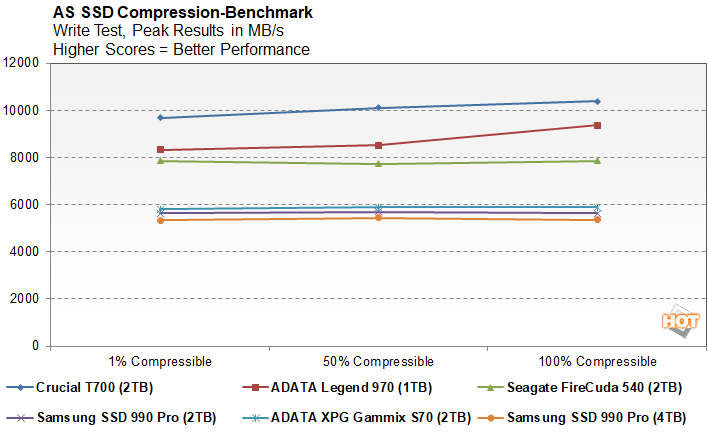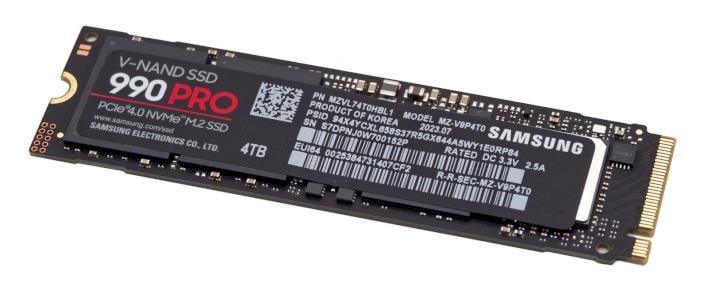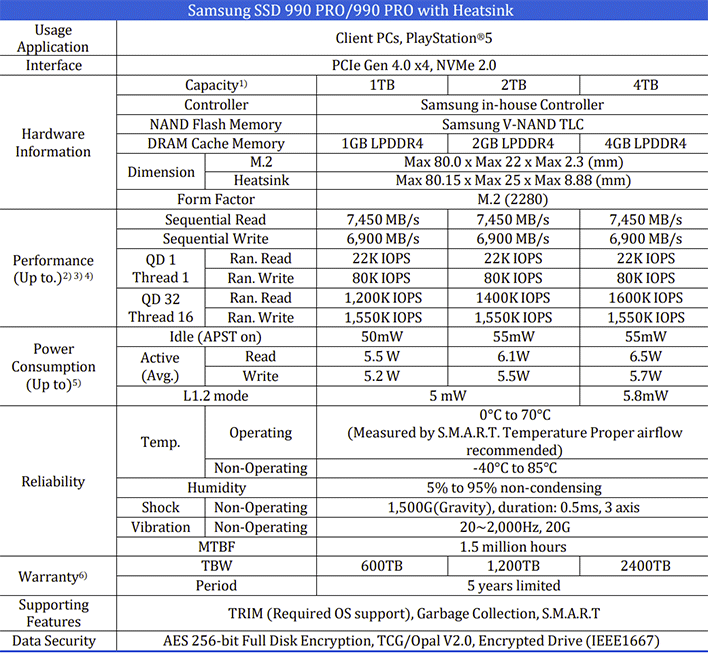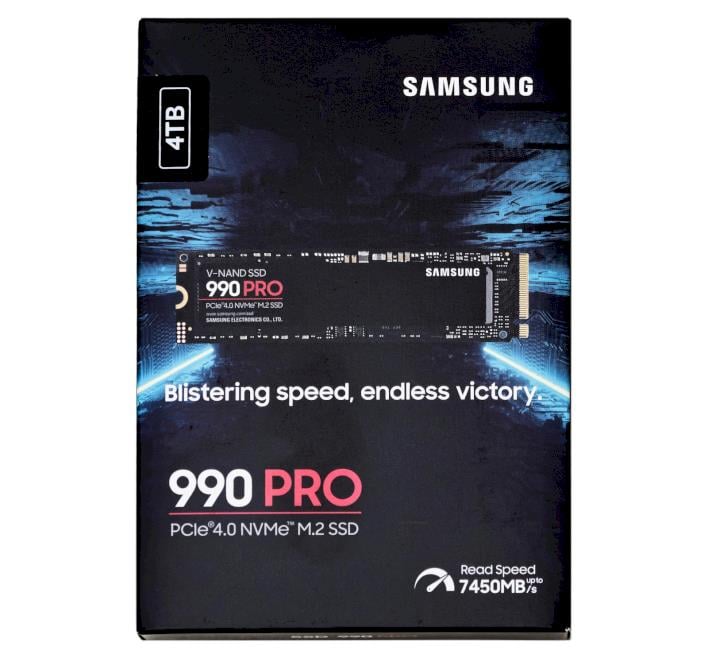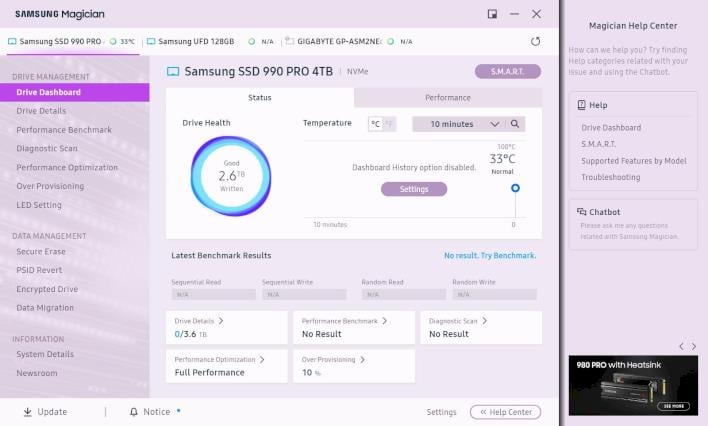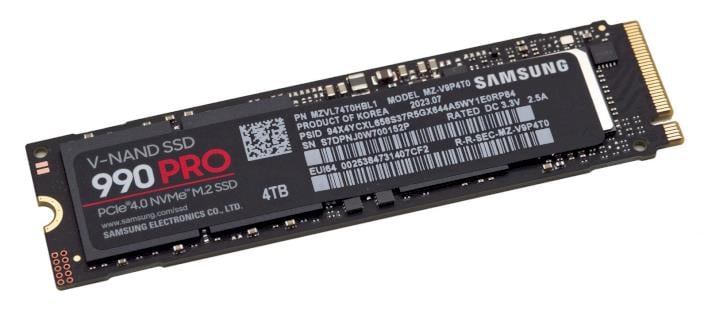Samsung SSD 990 Pro 4TB Review: Big, Fast Storage For PCs And PS5
Samsung SSD 990 Pro 4TB: Cool, High-Capacity PCIe Gen 4 Storage
| Samsung SSD 990 Pro: Starting At $69, 4TB - $334 MSRP Samsung has boosted the SSD 990 Pro series capacity to 4TB, while maximizing performance in PCIe Gen 4 systems.
|
|||

|

|
||
Late last month, Samsung revealed that it would finally be adding the promised 4TB model to its 990 Pro family of solid state drives. Like the existing members of the Samsung SSD 990 Pro series, the 4TB model would be an enthusiast-class, PCIe Gen 4 NVMe drive, targeting creators and gamers. Samsung didn’t just slap a couple of additional pieces of NAND on an existing drive, though. Despite offering double the capacity of the previous 2TB flagship, the new 4TB drive remains single sided, so it’ll fit in thin and light notebooks, AIOs, and small form factor systems that sometimes have clearance issues with thicker, double-sided M.2 SSDs. Like its siblings, the 4TB model is also well suited to the PlayStation 5.
Take a look at the 4TB Samsung SSD 990 Pro’s main features and specifications below, then we’ll dig in a little deeper and get to some numbers to see how this high-capacity SSD stacks up to today's competition...
Samsung SSD 990 Pro Specifications And Features
Samsung SSD 990 Pro Gen 4 drives were initially offered in two capacities—1TB and 2TB—and in two flavors, with and without an integrated heatsink. The new 4TB model doubles the max capacity of the previous-top end drive, and it too will be sold solo or with a heatsink.
All of the drives in the Samsung SSD 990 Pro series use the common M.2 (2280) ‘gumstick’ form factor, but the random read and write performance between the different models varies slightly depending on the capacity -- sequentials are similar, however. All of the drives are rated for up to 7.45GB/s (reads) and 6.9GB/s (writes), which is essentially the limit for a PCIe Gen 4 NVMe SSD, with similar IOPs at QD1 (Queue Depth), but at QD32 the high-capacity drives offer slightly higher random read performance.
The 4TB Samsung SSD 990 Pro drives’ max random write IOPS rating peaks at around 1,550K at QD32, with reads around 1,600K, which is the best in the line-up. The 990 Pro series drives endurance ratings also vary based on capacity, as you would expect, with the 1TB model landing at the 600TBW mark, the bigger 2TB drive hitting 1,200TBW, and the big-daddy 4TB model doubling that to 2,400TBW.
The Samsung SSD 990 Pro series features Samsung’s latest V-NAND flash memory. To be specific, the drives are equipped with up to 144 layer TLC 3-bit per cell V-NAND flash with 3D charge trap flash (CTF) cells. Samsung’s latest V-NAND offers lower latency for reads and writes, at similar or lower power than its previous-generation V-NAND. The 4TB drive leverages V8 1Tb high-density NAND to boost capacity (the 1TB and 2TB drives use V7), without the need to add additional pieces of NAND to the back side of the PCB.
990 Pro series drives are also outfitted with Samsung's Pascal controller, which is manufactured on the company's 8nm process node and reportedly offers a nearly 50% improvement in performance-per-watt over older Samsung drives. According to Samsung, the 980 Pro offered sequential Read / Write performance of about 1,129MB / 877MB per watt, whereas the new 990 Pro can hit a sequential Read / Write of 1,380MB / 1,319MB per watt based on internal testing of the 1TB model.
The Samsung SSD 990 Pro’s controller supports all of the features you’d expect from a modern SSD, like TRIM, garbage collection, S.M.A.R.T., etc., in addition to various encryption technologies. Depending on the capacity, the drives also feature 1GB, 2GB, or 4GB of discrete LPDDR4 DRAM cache, with the new 4TB drive packing the maximum config.
Like the last couple generations of Samsung Pro SSDs, the controller has a nickel coating that helps to dissipate heat and the underside of the drives has a thin plate hidden underneath a decal to aid in cooling. The drives also support Samsung's Dynamic Thermal Guard feature, which helps manage power and thermals based on the drives' workload to minimize any potential throttling.
Samsung SSD 990 Pro drives also feature TurboWrite technology, similar to Samsung EVO-branded drives. TurboWrite uses a portion of the drive's V-NAND as an SLC write buffer, which results in improved write performance, as long as the buffer isn’t exhausted. As was the case with previous-gen drives, the TurboWrite buffer dynamically adjusts in size based on the workload.
TurboWrite will also allow the Samsung SSD 990 Pro drives to perform well in the vast majority of consumer-class workloads, because writes are fastest when the SLC buffer is being utilized. Once the buffer is exhausted, write performance can taper off, but on the 4TB drive, the SLC cache is flushed fast enough to maintain strong write performance across the entire capacity of the drive.
Samsung warranties the SSD 990 Pro series drives for 5 years, which is in-line with previous-gen offerings, and the drives are also supported by Samsung’s Magician SSD management utility. Version 8 of Samsung Magician should be hitting the web right around the time you're this. This new version of Magician integrates the traditional feature of Magician available to standalone SSD, with Samsung's Portable SSD application, Data migration tool, and SD Card authentication application.
Samsung SSD 990 Pro 4TB Benchmarks
Under each test condition, the SSDs showcased here were installed as secondary volumes in our testbed, with a separate drive used for the OS and benchmark installations. Our testbed's motherboard was updated with the latest BIOS available at the time of publication and Windows 11 was fully updated. Windows firewall, automatic updates, and screen savers were all disabled before testing and Focus Assist was enabled to prevent any interruptions.
In all test runs, we rebooted the system, ensured all temp and prefetch data was purged, and waited several minutes for drive activity to settle and for the system to reach an idle state before invoking a test. All of the drives here have also been updated to their latest firmware as of press time. Where applicable, we would also typically use any proprietary NVMe drivers available from a given manufacturer, but all of the drives featured here used the Microsoft driver included with Windows 11.
HotHardware's Test System:
| Processor: Intel Core i9-13900KS Motherboard: MSI Z790 Carbon Wi-Fi (Z790 Chipset) Video Card: GeForce RTX 3080 Memory: 32GB Corsair DDR5-5800 Storage: Samsung SSD 980 Pro (OS Drive) ADATA XPG GAMMIX S70 (2TB) ADATA Legend 970 (2TB) Seagate Firecuda 540 (2TB) Samsung SSD 990 Pro (2TB) Samsung SSD 990 Pro (4TB) Corsair T700 (2TB) |
OS: Windows 11 Pro x64 Chipset Drivers: AMD v3.10.22.706 Benchmarks: IOMeter 1.1 HD Tune v5.75 ATTO v4.01.02f AS SSD SiSoftware SANDRA CrystalDiskMark v8.0.4 x64 Final Fantasy XIV: Endwalker PCMark 10 Quick Storage Bench 3DMark Storage Tests |
IOMeter Benchmarks
IOMeter is a well-respected industry standard benchmark. However, despite our results with IOMeter scaling as expected, it is debatable as to whether or not certain access patterns actually provide a valid example of real-world performance. The access patterns we tested may not reflect your particular workloads, for example. That said, we do think IOMeter is a reliable gauge for relative throughput, latency, and bandwidth with a given storage solution. In addition, there are certain highly-strenuous workloads you can place on a drive with IOMeter, that you can't with most other storage benchmark tools.In the following tables, we're showing two sets of access patterns; a custom Workstation pattern, with an 8K transfer size, consisting of 80% reads (20% writes) and 80% random (20% sequential) access and a 4K access pattern with a 4K transfer size, comprised of 67% reads (33% writes) and 100% random access. Queue depths from 1 to 16 were tested...
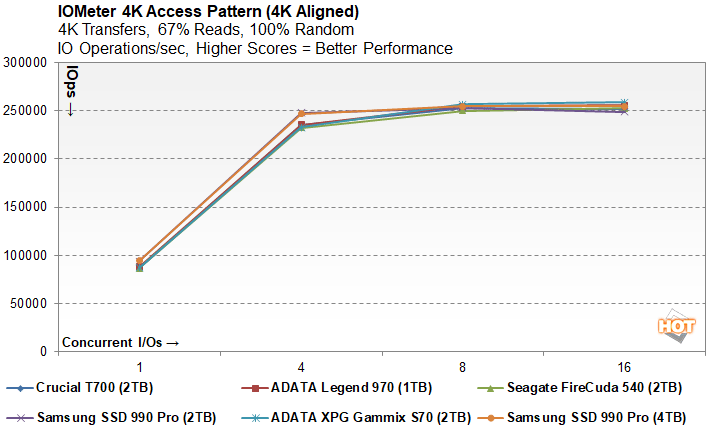
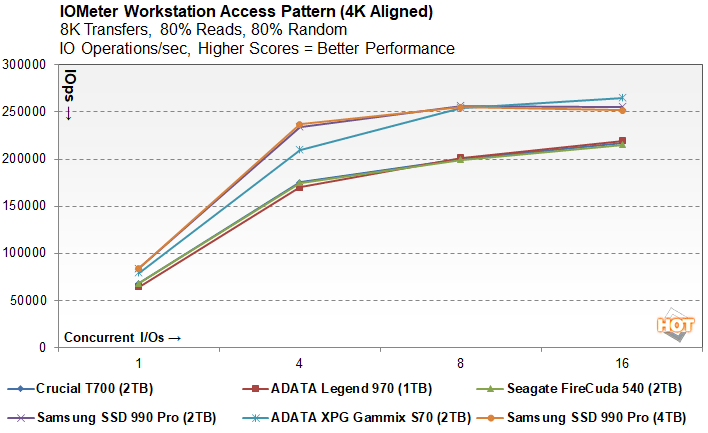
At the lower queue depths, the Samsung SSD 990 Pro led the pack, but performance plateaued beyond QD4 and the other drives caught up at the higher queue depths. Note that for consumer workloads, the lowest queue depths are most important, so the 990 Pro is in good shape here.
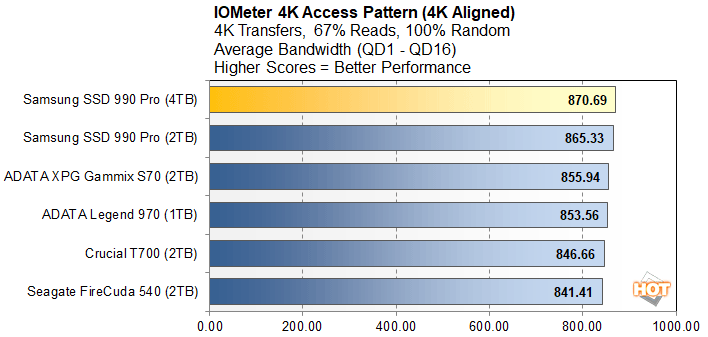
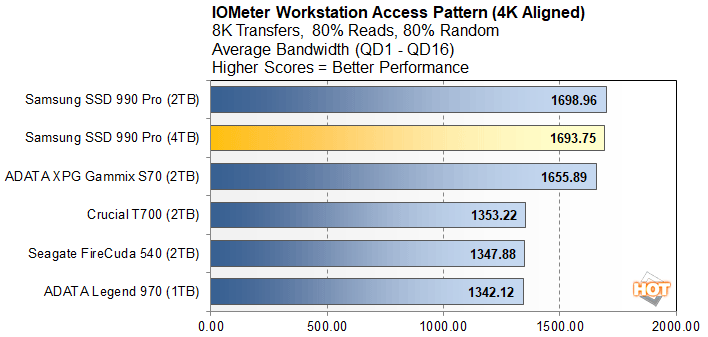
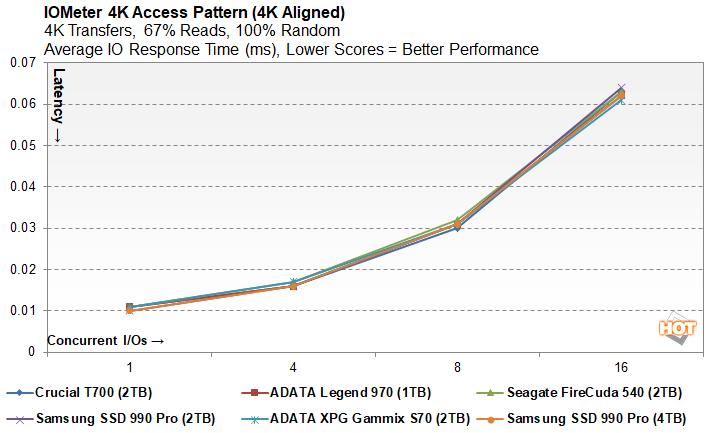

Our latency results also show the Samsung SSD 990 Pro offering some of the lowest (best) latency at the lower queue depths. It's only at the highest queue depth (QD16) that the 990 Pro's latency trails the ADATA XPG Gammix S70, but the deltas were minor.
SiSoft SANDRA 2021
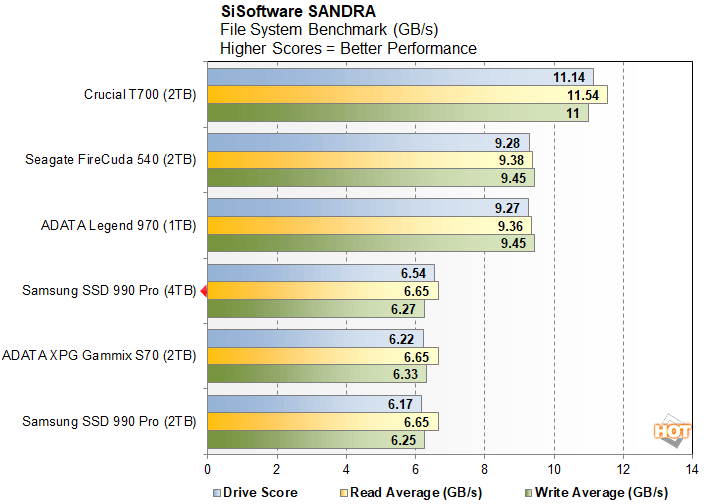
The 4TB Samsung SSD 990 Pro topped the other PCIe Gen 4 SSDs we tested here, finishes well behind some the latest PCIe Gen 5, especially the Crucial T700, which is among the fastest drives currently on the market.
ATTO Disk Benchmark
ATTO is another "quick and dirty" type of disk benchmark that measures transfer speeds across a specific volume length. It measures raw transfer rates for both reads and writes and graphs them out in an easily interpreted chart. We chose .5KB through 64MB transfer sizes and a queue depth of 6 over a total max volume length of 256MB. ATTO's workloads are sequential in nature and measure raw bandwidth, rather than I/O response time, access latency, etc.
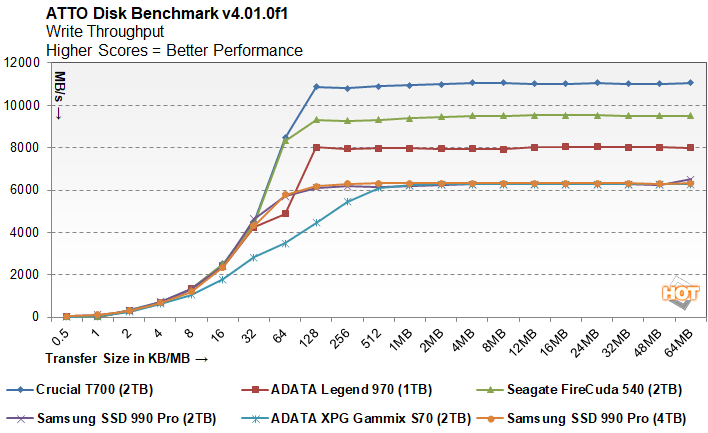

Among the PCIe Gen 4 drives, the 4TB Samsung SSD 990 Pro offers top performance in the ATTO Disk Benchmark. The latest PCIe Gen 5 drives, however, offer much higher throughput here, at least in terms of sequential transfers.
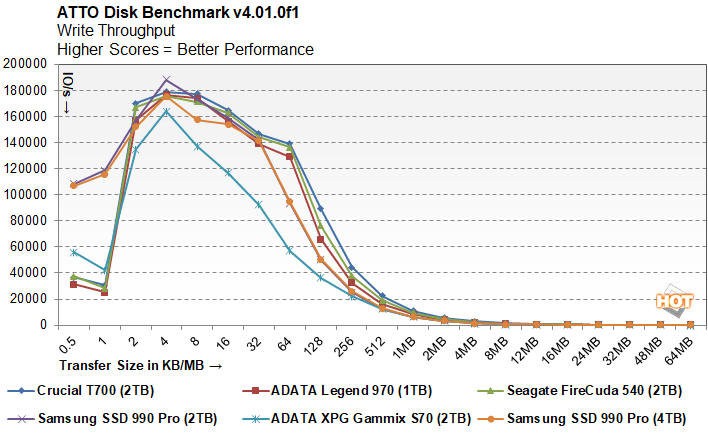

IO performance is generally similar with all of the drives we tested in the read test, but the Samsung SSD 990 Pro drives offered the highest performance with the smallest transfer sizes in the write test.
AS SSD Compression Benchmark
Next up we ran the Compression Benchmark built-into AS SSD, an SSD specific benchmark being developed by Alex Intelligent Software. This test is interesting because it uses a mix of compressible and non-compressible data and outputs both Read and Write throughput of the drive. We only graphed a small fraction of the data (1% compressible, 50% compressible, and 100% compressible), but the trend is representative of the benchmark’s complete results.

